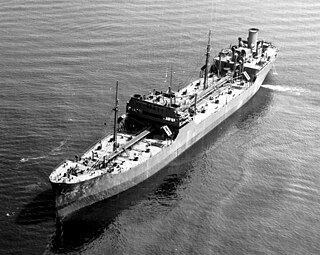
USS Pecos (AO–65) was laid down 20 April 1942 by the Sun Shipbuilding and Dry Dock Co. as a type T3-SE-A1 tanker, Chester, Pennsylvania, as Corsicana ; launched 17 August acquired by the Navy 29 August 1942; and commissioned 5 October 1942.

USS Cimarron (AO-22) was a Cimarron-class oiler serving with the United States Navy and the second ship to be named for the Cimarron River in the Southwestern United States. She was launched 7 January 1939 by Sun Shipbuilding and Drydock Company, Chester, Pennsylvania; sponsored by Mrs. William D. Leahy; and commissioned 20 March 1939.

USS Kaskaskia (AO-27) was a Cimarron-class fleet replenishment oiler serving in the United States Navy, named for the Kaskaskia River in Illinois.

USS Neosho (AO–48) was a Kennebec-class type T2 fleet oiler of the United States Navy. The ship was laid down on 8 July 1941, as SS Catawba, by the Bethlehem-Sparrows Point Shipyard Inc., Sparrows Point, Maryland. The purchase came under Maritime Commission contract number 145 for the Socony-Vacuum Oil Company, later renamed Mobil Oil.

USS Neches (AO-47) was a Kennebec-class oiler in the United States Navy during World War II and the Vietnam War. She was the second U.S. Navy ship named for the Neches River in eastern Texas.

USS Suamico (AO-49) was the lead ship of her class of Type T2-SE-A1 fleet oilers of the United States Navy.

USS Saugatuck (AO-75) was a Suamico-class replenishment oiler of the United States Navy.

USS Tallulah (AO-50), originally named the SS Valley Forge, was a Type T2-SE-A1 Suamico-class fleet oiler of the United States Navy.

USS Millicoma (AO-73) was a United States Navy fleet oiler which served in the Pacific Theatre during World War II, winning eight battle stars for her dangerous work. Post-war she was recommissioned and was placed under the control of the MSTS with a civilian crew until finally assigned for disposal in 1987.

USS Saranac (AO-74), originally named the SS Cowpens, was a Type T2-SE-A1 Suamico-class fleet oiler of the United States Navy, and the fourth ship of the Navy to bear the name.

USS Cowanesque (AO-79) was a Type T2-SE-A1 Suamico-class fleet oiler of the United States Navy during World War II.

USS Caliente (AO-53) was a Cimarron-class fleet oiler built during World War II for the U.S. Navy. During her career in the Pacific Ocean, Caliente participated in World War II, the Korean War, and the Vietnam War. She was highly decorated for fulfilling her dangerous mission of carrying fuel into battle areas. She received ten battle stars for World War II, four for the Korean War and eight campaign stars for the Vietnam War.

USS Lamons (DE-743) was a Cannon-class destroyer escortin service with the United States Navy from 1944 to 1946. She was sold for scrapping in 1973.

USS Sebec (AO-87) was a Escambia-class fleet oiler acquired by the United States Navy for use during World War II. She had the dangerous but necessary task of providing fuel to vessels in combat and non-combat areas primarily in the Pacific Ocean. For her valiant efforts, she received six battle stars during the war.

USS Escambia (AO-80) was the lead ship of her subclass of the Suamico class of fleet oilers acquired by the United States Navy for use during World War II. She had the dangerous, but necessary task of providing fuel to vessels in combat and non-combat areas primarily in the Pacific Ocean. For her valiant efforts, she received five battle stars during the war.

USS Cahaba (AO-82) was an Escambia-class replenishment oiler acquired by the United States Navy for use during World War II. She had the dangerous but necessary task of providing fuel to vessels in combat and non-combat areas primarily in the Pacific Ocean. For her brave efforts, she received eight battle stars during the war.

USS Pamanset (AO-85) was a Escambia-class replenishment oiler acquired by the United States Navy for use during World War II. She had the dangerous but necessary task of providing fuel to vessels in combat and non-combat areas.

USS Ashtabula (AO-51) was a Cimarron-class fleet oiler of the United States Navy in service from 1943 to 1991. She survived three wars and was awarded eight battle stars for World War II service, four battle stars for Korean War service, and eight campaign stars for Vietnam War service. In the mid-1960s Ashtabula became the lead ship of her class, when she and seven other Cimarron-class oilers were lengthened ("jumboized"). She has been the only U.S. Navy ship to bear the name Ashtabula, after the City of Ashtabula which was named after the Ashtabula River in northeast Ohio.

USS Kern (AOG-2) was a Patapsco-class gasoline tanker acquired by the United States Navy for the dangerous task of transporting gasoline to warships in the fleet, and to remote Navy stations.

USS Jicarilla (ATF-104) was Abnaki-class tugboat during the World War II. The ship was later sold to Colombia as ARC Sebastián De Belalcázar (RM-73). Her namesake is a group of the Apache tribe found in the southwestern United States.




















